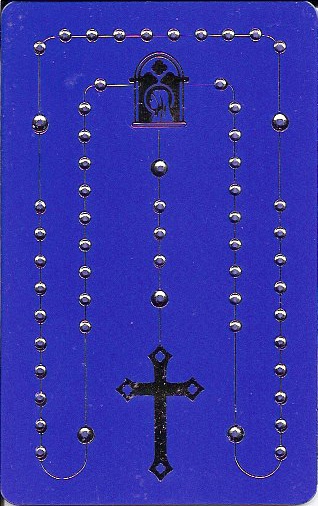The Row Boat has already become something of a destination for people interested in wallets. This post is a contribution to that burgeoning tradition.
 My friend/hero Will, who for the months since his success in electing Barack Obama president has made it his business to travel around “visiting people,” sent me a delightful little gift that he picked up at the gift shop of the new Catholic cathedral in Oakland, California. It’s a rosary, made out of bumps on the surface of a wallet-size plastic card. Oh, my heart leaped for joy!
My friend/hero Will, who for the months since his success in electing Barack Obama president has made it his business to travel around “visiting people,” sent me a delightful little gift that he picked up at the gift shop of the new Catholic cathedral in Oakland, California. It’s a rosary, made out of bumps on the surface of a wallet-size plastic card. Oh, my heart leaped for joy!
Regretfully, the pleasure came less from the sight of an implement of the Most Blessed and Holy Rosary than from the fact that it looks so much like a circuit board. Little silver bumps are connected by a silver thread. There’s no evidence that said silver paint would conduct electricity, or that the bumps offer any service as nodes other than to mark the decades of the prayer. But the idea, the idea is fantastic! The ideas! There are so many great ideas packed into this thing:
- A usable rosary on a flat surface. I don’t think I’ve ever seen that before.
- And, no less, a flat surface that happens to fit perfectly into the modern wallet. One need never embarrass one’s friends again by wearing one’s rosary around one’s neck or wrists. What a relief.
- And the possibility, if not the actuality, of having a rosary that also doubles as a circuit board. Doubly useful, doubly magical. I’ve always been a fan of convergences between technological and religious objects (e.g.), though I don’t think I’ve ever succeeded in explaining why.
So thanks, Will!
Something in addition. It occurred to me years ago that there’s a mathematical relationship between Buddhist and Catholic rosaries. Not counting the “extra” beads that hang off the cross, the Catholic rosary has 54 beads. The standard Buddhist mala has 108 beads, a number which has lots of different significances. That means so-inclined Catholics could (at the risk of doctrinal error, according to some) do a Buddhist prayer cycle on their regular rosaries simply by ignoring the stuff dangling from the cross and going around twice. Unfortunately, doing the Catholic prayers on the Buddhist device would be much more difficult.
There’s also an etymological connection. Both the Latin rosarium and the Sanskrit mala signify a garland of flowers. Is there a reason both traditions pray on garlands of flowers in multiples of 54? I assume there’s a Silk Road-related relationship, but if anybody knows more, please do let me know.